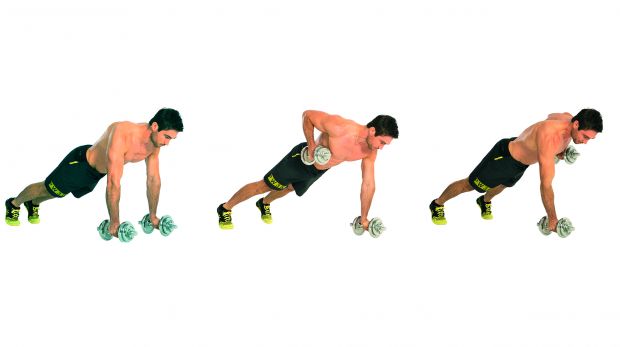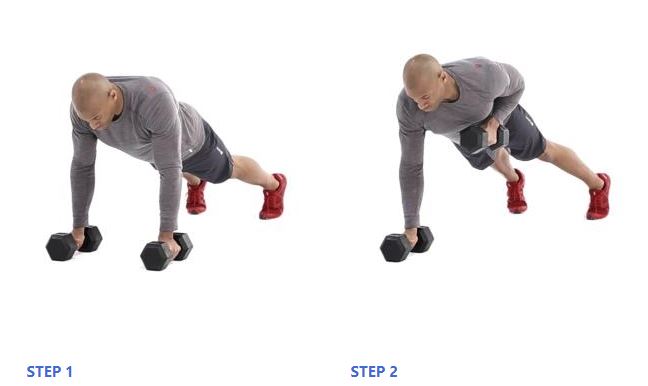The renegade row is a compound, high performance exercise that attacks a weak core, improves performance, and stimulates muscle growth. It also helps you prevent injury and build a rock-solid physique from head to toe.
- Renegade rows train anti-extension. When you hold proper position without arching your back, you’ll hammer your anterior core to build strength and endurance. Strength combined with the ability to prevent movement when fatigued, the key to preventing injuries.
- They train anti-rotation. An example of anti-rotation is checking your swing in baseball. Rotational power is important for athletes, but to build powerful rotation you must first be able to prevent it. With each rep on the renegade row, you’ll need to row slowly while pushing both hands and feet into the ground to prevent movement.
- They hammer your chest, triceps, and shoulders. Your hands are elevated on dumbbells, leading to a deeper push-up. A deeper range of motion means a greater stretch of your muscles, leading to a greater concentric contraction. During each row, you’ll need to push the non-rowing dumbbell into the ground. This creates a wicked isometric contraction of your chest, shoulders, and triceps.
- As a bonus, each set of renegade rows takes 30-60 seconds. Evidence points to time under tension (TUT) being a primary driver for metabolic stress-induced hypertrophy. When done for many sets, the cumulative time under load cooks your upper body and makes for an excellent high-performance finisher.
- They train your lats. You’ll need to row the dumbbell back towards your hip in a “J” pattern. When rowing in this fashion, the lats are the primary focus rather than the traps, rhomboids, and rear delts. Further, your push-up is deeper due to elevating your hands on dumbbells. This hits your lats harder (as well as your chest) as they work overtime to stabilize your shoulders. If you’re not accustomed to deep push-ups, this exercise will create wicked soreness in your lower lats.
- They integrate strength and stability. Your core prevents unnecessary movement and the renegade row strengthens that ability. This protects internal structures, like your spine, from folding like an accordion and setting you up for months of physical therapy.

- Assume a push-up position with the dumbbells beneath your shoulders and your arms locked out. This stacked-joint position sets the stage for optimal results.
- Keep your hips level, not with your back arched.
- Spread your feet a little wider than shoulder width. A wider base aids you in preventing rotation. As you progress, you can bring the feet closer, as long as you’re able to prevent your hips and spine from rotating.
- Perform a full push-up. Tuck your elbows to about 45 degrees, making a “V” shape with your torso and arms.
- After the push-up, row one dumbbell towards your hip while pushing the non-working dumbbell and your toes into the ground. This will serve as a cue to keep your toes from coming off the floor and will help you stabilize and prevent rotation.
- Row slow and prevent your hips from rotating. If you can’t control rotation, you’re using too much weight or going too fast.
- Return the dumbbell to the floor, repeat on the opposite side. That’s one complete rep.

